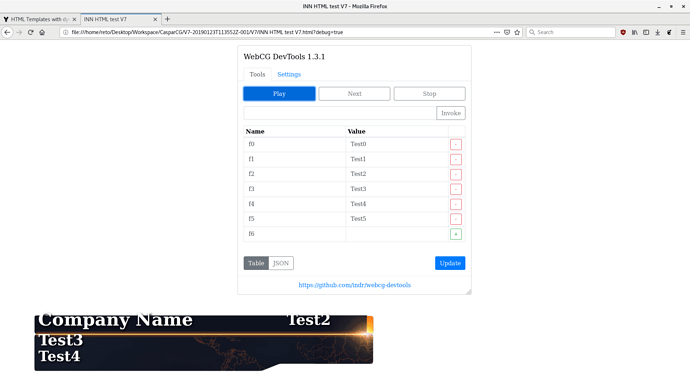hi everyone, I’m looking for some help with the HTML templates I’ve just started working with them and I’m just learning programing. I’m working with Animate CC 2019. I’m creating a lower 3rd template. I have the animation working and can call it in using the html tool. I would like to be able to use the CCG client to change the text fields. but I’m not sure how, I tried using the wiki page but couldn’t get it to work. i’m using CG 2.2.0
bellow is my code and I have attached it, INN HTML test.html (4.5 KB)
<!DOCTYPE html>
<!--
NOTES:
1. All tokens are represented by '$' sign in the template.
2. You can write your code only wherever mentioned.
3. All occurrences of existing tokens will be replaced by their appropriate values.
4. Blank lines will be removed automatically.
5. Remove unnecessary comments before creating your template.
-->
<html>
<head>
<meta charset="UTF-8">
<meta name="authoring-tool" content="Adobe_Animate_CC">
<title>INN HTML test</title>
<!-- write your code here -->
<script src="https://code.createjs.com/createjs-2015.11.26.min.js"></script>
<script src="INN HTML test.js"></script>
<script>
// Global Scripts
var json = {};
saved = saved.replace(/^(<templateData>|<componentData>|<data>)|(<\/templateData>|<\/componentData>|<\/data>)$/ig, );
try {
json = JSON.parse(decodeURI(saved));
} catch (e) {}
for (var key in json) {
sym.$(key).html(json[key]);
}</script>
<script>
var canvas, stage, exportRoot, anim_container, dom_overlay_container, fnStartAnimation;
function init() {
canvas = document.getElementById("canvas");
anim_container = document.getElementById("animation_container");
dom_overlay_container = document.getElementById("dom_overlay_container");
var comp=AdobeAn.getComposition("5DBB8DE787B53148940396A431E80D97");
var lib=comp.getLibrary();
var loader = new createjs.LoadQueue(false);
loader.addEventListener("fileload", function(evt){handleFileLoad(evt,comp)});
loader.addEventListener("complete", function(evt){handleComplete(evt,comp)});
var lib=comp.getLibrary();
loader.loadManifest(lib.properties.manifest);
}
function handleFileLoad(evt, comp) {
var images=comp.getImages();
if (evt && (evt.item.type == "image")) { images[evt.item.id] = evt.result; }
}
function handleComplete(evt,comp) {
//This function is always called, irrespective of the content. You can use the variable "stage" after it is created in token create_stage.
var lib=comp.getLibrary();
var ss=comp.getSpriteSheet();
var queue = evt.target;
var ssMetadata = lib.ssMetadata;
for(i=0; i<ssMetadata.length; i++) {
ss[ssMetadata[i].name] = new createjs.SpriteSheet( {"images": [queue.getResult(ssMetadata[i].name)], "frames": ssMetadata[i].frames} )
}
exportRoot = new lib.INNHTMLtest();
stage = new lib.Stage(canvas);
//Registers the "tick" event listener.
fnStartAnimation = function() {
stage.addChild(exportRoot);
createjs.Ticker.setFPS(lib.properties.fps);
createjs.Ticker.addEventListener("tick", stage);
}
//Code to support hidpi screens and responsive scaling.
function makeResponsive(isResp, respDim, isScale, scaleType) {
var lastW, lastH, lastS=1;
window.addEventListener('resize', resizeCanvas);
resizeCanvas();
function resizeCanvas() {
var w = lib.properties.width, h = lib.properties.height;
var iw = window.innerWidth, ih=window.innerHeight;
var pRatio = window.devicePixelRatio || 1, xRatio=iw/w, yRatio=ih/h, sRatio=1;
if(isResp) {
if((respDim=='width'&&lastW==iw) || (respDim=='height'&&lastH==ih)) {
sRatio = lastS;
}
else if(!isScale) {
if(iw<w || ih<h)
sRatio = Math.min(xRatio, yRatio);
}
else if(scaleType==1) {
sRatio = Math.min(xRatio, yRatio);
}
else if(scaleType==2) {
sRatio = Math.max(xRatio, yRatio);
}
}
canvas.width = w*pRatio*sRatio;
canvas.height = h*pRatio*sRatio;
canvas.style.width = dom_overlay_container.style.width = anim_container.style.width = w*sRatio+'px';
canvas.style.height = anim_container.style.height = dom_overlay_container.style.height = h*sRatio+'px';
stage.scaleX = pRatio*sRatio;
stage.scaleY = pRatio*sRatio;
lastW = iw; lastH = ih; lastS = sRatio;
stage.tickOnUpdate = false;
stage.update();
stage.tickOnUpdate = true;
}
}
makeResponsive(false,'both',false,1);
AdobeAn.compositionLoaded(lib.properties.id);
fnStartAnimation();
}
</script>
<!-- write your code here -->
</head>
<body onload="init();" style="margin:0px;">
<div id="animation_container" style="background-color:rgba(#ffff); width:1920px; height:1080px">
<canvas id="canvas" width="1920" height="1080" style="position: absolute; display: block; background-color:rgba(#ffff);"></canvas>
<div id="dom_overlay_container" style="pointer-events:none; overflow:hidden; width:1920px; height:1080px; position: absolute; left: 0px; top: 0px; display: block;">
</div>
</div>
</body>
</html>
